SIPOC can help you improve your business process, make team members happy, and simultaneously fulfill customer requirements by enhancing your management approach. Quality management derives from outlining the entire work process from start to finish, using the SIPOC diagram.
The SIPOC diagram is used in process mapping, a technique “of using flowcharts to illustrate the flow of a process, proceeding from the most macro perspective to the level of detail required to identify opportunities for improvements,” according to Northern Illinois University.
Learning SIPOC and Six Sigma (techniques and tools for process improvement) is useful to delivery leaders, business analysts, data analysts, project managers, process improvement experts, program managers, and operation team leaders.
Essentially, SIPOC helps businesses underline any issues in the process and strive for continuous improvements.
What Is SIPOC?
SIPOC is an acronym for suppliers, inputs, process, outputs, and customers. SIPOC is used in the business world. SIPOC, often referred to as COPIS, aims to put customer needs first. It is a tool meant for business owners and project managers to plan a process to get goods from suppliers to customers.
SIPOC is also a map that works as a visual aid for you to discover more about the inputs (suppliers) and outputs (customer) process, and everything in between. This map helps you understand how the suppliers, staff work routines, and the general running of the business can affect customer needs.
What Is SIPOC Used for?
SIPOC is used to help improve manufacturing or business procedures. Below is an overview of how to use a SIPOC diagram to enhance your operations.
- Business planning. Starting with a SIPOC diagram can help plan procedures for those starting a business.
- Same page. It can keep management or senior staff on the same page as team members, and everyone in the company has clear outlines.
- Identify gaps and goals. It can highlight what business tasks are leading to unsatisfied customers or can help you set goals for improving the business.
- Improving processes. It can enhance a business at each stage of the process. This form of analysis can lend valuable insights into what needs to change to become better.
- Defining a new process. It can also help businesses determine a new process for those taking their teams in a new direction.
SIPOC Diagrams Explained
Below is a look at the type of content you might find on a SIPOC diagram. These are listed in order of a typical map to give you a sense of this flow chart.
Suppliers
This is the first step in a business. Traditionally, the suppliers supply a grocery shop with food and a car manufacturer with car parts, for example. This step also details the person who delivers the needs of the customer. This means the team members at the tills process customer orders.
Inputs
Inputs refer to required information such as customer orders. For example, in a cafe, the information required would be a customer’s orders of a latte and a sandwich.
Process
The process part of the diagram details the process of fulfilling an order. With our cafe example, the process would involve receiving an order, making the latte and sandwich before notifying the customer the order is ready.
Outputs
This process completes a purchase order. It involves the purchase receipt and customer satisfaction.
Customer
The customer supplies inputs at the start of the process and gains the output. A store owner is also a “customer” as he or she needs to secure the ingredients and goods to be sold.
Learning SIPOC
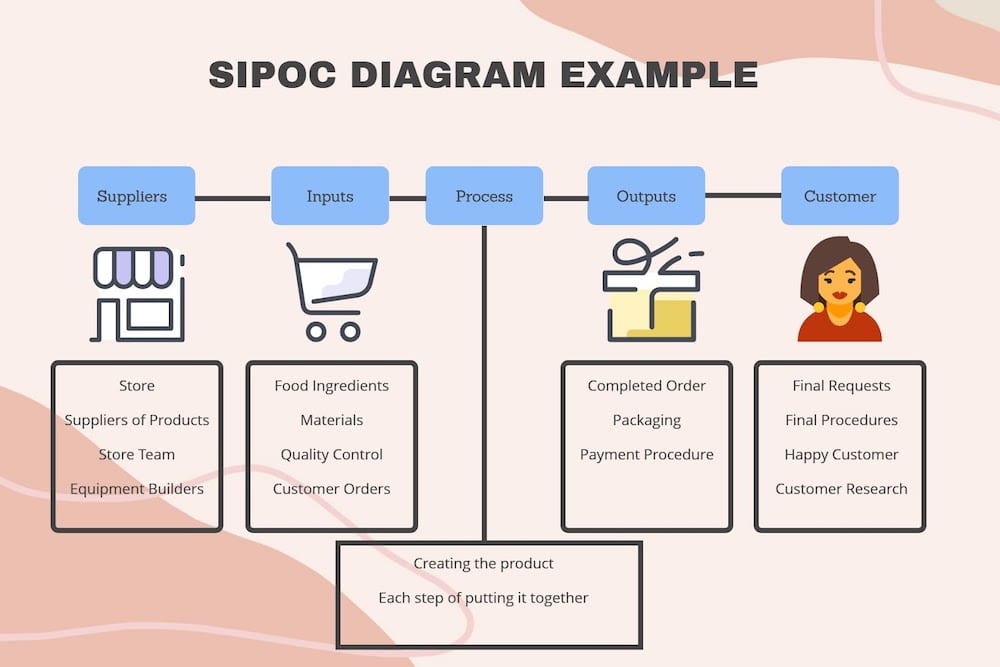
Learning SIPOC is relatively intuitive. Therefore, it does not require a university degree. Learning SIPOC requires simple training you can do online with Six Sigma or other education providers. Generating an effective SIPOC requires certification that usually has different levels of knowledge.
Your qualification in SIPOC is often referred to as “belts.” The yellow belt is a beginner certification, while the black belt is an expert level. Check our certificates section below for more belt details. Once completed, you should be a SIPOC professional.
How Long Does It Take to Learn SIPOC?
The time you need to learn SIPOC depends on how much you already know. Generally, beginners take no more than five days to learn it.
However, you can earn a green belt in about 50 hours, although that’s not where the journey ends for some learners. Advanced courses can exceed five months and these are available for you to become an expert in the Six Sigma field.
Know that SIPOC is a quick and effective strategy to learn and can help you find a deeper understanding of the business process and upskill yourself.
How to Learn SIPOC: Step-by-Step
Below is a quick guide on how to begin creating your SIPOC diagram. We start from the bottom and work our way up to the supply chain to fully understand customer needs first.
- Process outline. Create an outline of the customer and company process.
- Identify your customer. Who is your customer? What do they want, and how can you provide that want for them? Try to think of customers and their particular queries in detail.
- Identify the outputs. Discover what output steps you need to take and identify what product you want to sell. Consider if there is paperwork customers need to fill out and what the payment process would be.
- Identify the inputs. What are the materials or ingredients required for the final product? A pizza restaurant might need an oven and a supply of pepperoni, dough, and cheese. Consider all the resources you need to process a customer request.
- Identify input suppliers. Who supplies the materials that go into making the final product? This can include actual store suppliers and employees.
The Best SIPOC Training and Courses
These are the best SIPOC training programs available online. Please note that some are offered for free, while others require a fee. Each of these programs provides certifications and the knowledge required to create a SIPOC diagram that you can use in your career.
Best Online SIPOC Courses
Below are the very best online courses that you need to pay for. They each provide good quality lessons that will boost your leadership skills and improve lean manufacturing or business practices.
Lean Sigma Corporation
- Lean Six Sigma Course
- Where: Online
- Time: 50–105 Hours
- Price: $1,290
This Lean Sigma certification teaches you all about SIPOC. Learn the Sigma DMAIC (data-driven improvement cycle) methodology, define a problem properly, measure it, determine critical solutions, and Six Sigma analytics to truly hone your leadership skills.
Grey Campus
Six Sigma Green Belt Training & Certification
Lean Six Sigma Yellow Belt Training Course
- Where: Online
- Time: 2–5 Days
- Price: $211.61–$1,587.06
Grey Campus offers intensive bootcamps and quick courses for Six Sigma. You can combine belts, like green and black, or obtain one individually. Here, you also have an optional exam you can take to be a certified Six Sigma expert skilled in lean manufacturing and business process management.
MSI – Management and Strategy Institute
- MSI Certified Six Sigma Training Course
- Where: Online
- Time: Self-paced (1-year limit)
- Price: $199.95
The MSI course is for Green Belts. It teaches you how to improve your business defects. Six Sigma Green Belts develop skills in the DMAIC process, and this is where they begin to implement process changes. They also work directly with Black Belts to learn to define processes within an organization.

"Career Karma entered my life when I needed it most and quickly helped me match with a bootcamp. Two months after graduating, I found my dream job that aligned with my values and goals in life!"
Venus, Software Engineer at Rockbot
Coursera
Six Sigma Green Belt Specialization
- Where: Online
- Time: 5 months
- Price: Varies (enroll for free)
These two Coursera courses are for beginner and advanced Six Sigma and Lean students. You will learn all about the measure phase, analysis, and the improvement phase.
Best Free SIPOC Courses
Here are two fantastic beginner choices for those considering taking the full Six Sigma or just want to focus on SIPOC. They are concise courses in comparison to the paid ones and in much less detail; however, they can get you started.
Go Lean Six Sigma
- SIPOC Training & Certificate
- Where: Online
- Time: 90 minutes
- Price: Free Trial ( $19 certification)
This course focuses solely on SIPOC and defines how a SIPOC relates to the DMAIC methodology. This is a great beginner’s course for those aiming to understand more about the value of SIPOC.
Master of Project Academy
- 30 Minutes Free Six Sigma Training
- Where: Online
- Time: 30 minutes
- Price: FREE
This is a free extract from Master of Project Academy’s Green Belt training. It is an entirely free short course that provides a certificate of completion. It is a brilliant beginner’s option for those preparing for the full Six Sigma training certificate.
Best SIPOC Books
The following books are expensive, but they are valuable learning resources. They are great for getting you started on data, Six Sigma, and SIPOC.
‘Lean Six Sigma in Service: Applications and Case Studies’, Sandra L. Furterer
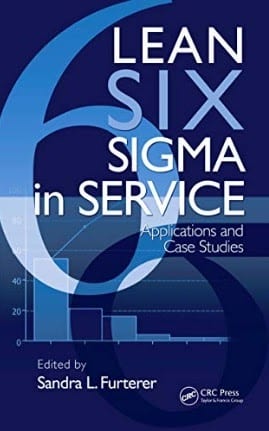
Lean Six Sigma in Service discusses how data can be messy and rarely always fits into normal statistical distributions. Learn about service industries and the variables that directly relate to and consistently change with the customer’s needs.
‘SIPOC A Complete Guide – 2021’, The Art of Service – SIPOC Publishing

This guide teaches you the value of defining, designing, creating, and implementing the right process for solving problems. That process needs to be designed with the right questions in mind, and this form of self-assessment empowers people to improve.
SIPOC Certifications Explained
Let’s take a closer look at each of the Six Sigma belts so you know the details, in case you’ve been bewildered by the karate references.
Yellow Belt
The yellow belt is the primary belt that helps the green and black belts. Yellow belts learn basic team management, process mapping (SIPOC), data collection, basic statistics, brainstorming, graphical analysis, and hypothesis testing.
Green Belt
Green belts go more in-depth into these topics. Green belt courses polish your abilities to implement Lean Six Sigma and your ability to define, measure, analyze, improve, and control (DMAIC).
Black Belt
Black belt lessons allow you to become pros by polishing your skills further while adding stakeholder analysis, project charter, data accuracy, patterns of variation, Lean solutions, and mistake-proofing.
Best Online SIPOC Resources
Options are available for those who are studying for exams or want additional online material to begin their learning. These come in video formats, online reading material, and guides.
YouTube.com
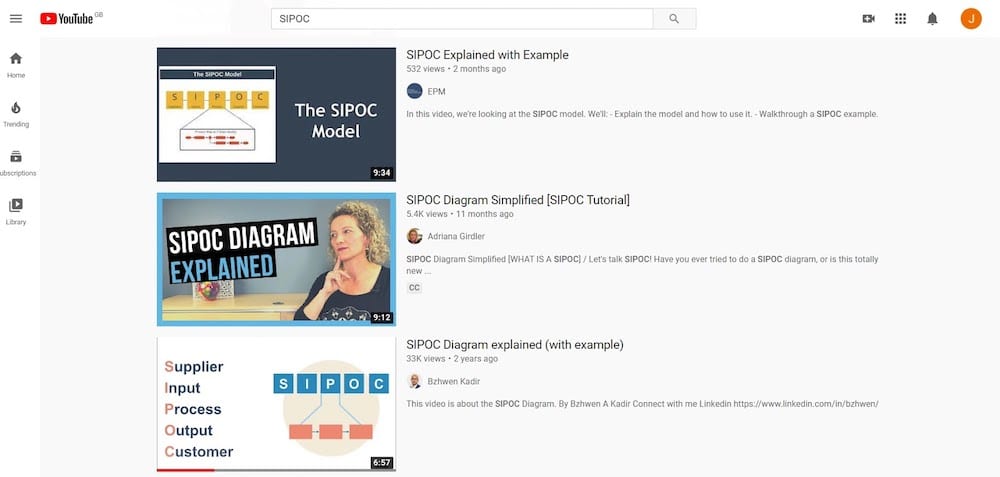
Youtube is a fantastic source of information. Look up “SIPOC” and you can watch the experts talk about the topic. Take advantage of the lessons you can learn on YoutTube. Obtaining a basic understanding of SIPOC concepts can lead you to a certification course and grow more skills.
Sixsigma.co.uk/blog
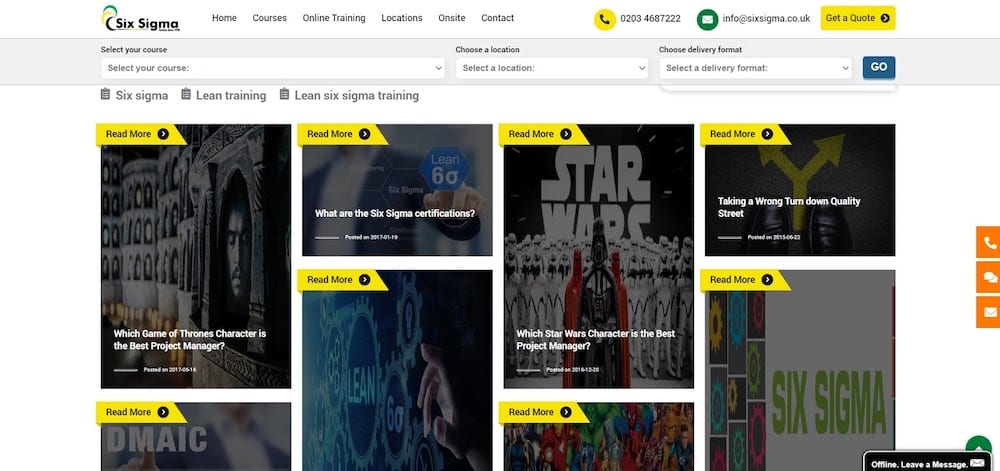
The Six Sigma website offers blog posts that walk you through the different belts, course information, the history of Six Sigma, and SIPOC. It also has plenty of training courses on Six Sigma online.
Projectmanager.com/training
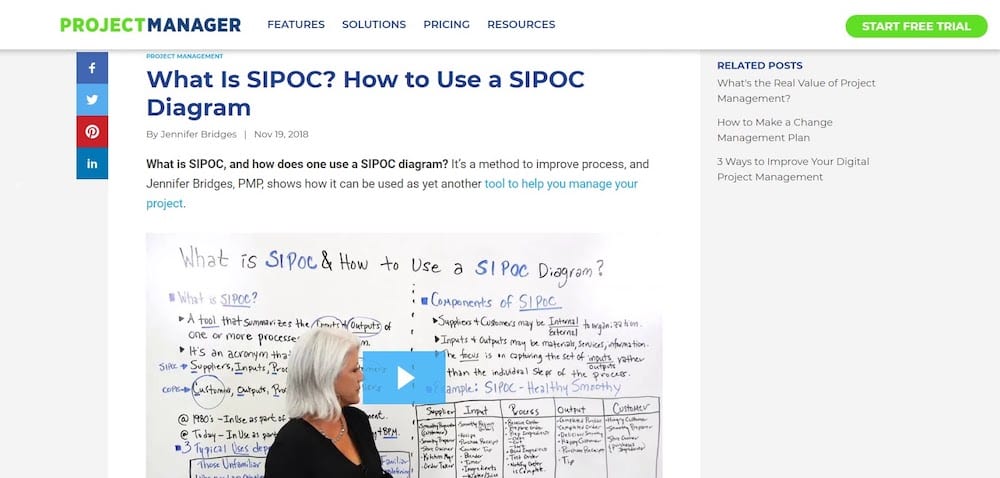
This particular blog is a great resource with a handy video that clearly explains the SIPOC diagram. This is the perfect resource if you are looking for a SIPOC diagram tutorial taught by Jennifer Bridges, a Project Management Professional (PMP).
Should You Study SIPOC?

This detailed process map is an excellent tool for any organization. Consider whether you want the full Lean and Six Sigma training or just a short course on SIPOC if you are interested. Either way, these are great tools for your leadership toolbelt.
Once you’ve learned the principles of SIPOC, and how to format and map out your business plan, you will be on the way to improving your process. If you are still interested in learning about other valuable tools like SharePoint or cloud computing, there are plenty of tips on the Career Karma website.
We at Career Karma hope this SIPOC learning guide has taught you how to fulfill the inputs required and requirements of the customer while helping you climb the business analytics and data analytics ladder.
About us: Career Karma is a platform designed to help job seekers find, research, and connect with job training programs to advance their careers. Learn about the CK publication.



